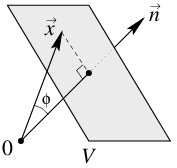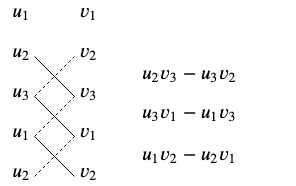Vectors: Distance, angle, dot product and cross product
 Normal vector and cross product in ℝ³
Normal vector and cross product in ℝ³
The term normal vector is also applicable to surfaces in \(\mathbb{R}^3\).
Normal equation of a plane Consider in \(\mathbb{R}^3\) a plane \(\mathcal{V}\) and let \(d\) be the distance from the origin \(O\) to \(\mathcal{V}\). Let \(\vec{n}\) a vector of length \(1\) that is perpendicular to \(\mathcal{V}\) and point toward \(\mathcal{V}\): \(\vec{n}\) is called a normal vector to the plane \(\mathcal{V}\).

By the length choice of the normal vector \(\vec{n}\) we can determine whether the terminal point of a vector \(\vec{x}\) lies on the plane \(\mathcal{V}\): a necessary and sufficient condition is that the projection of \(\vec{x}\) on the span of \(\vec{n}\) has length \(d\). The formula is: \[\text{terminal point of }\vec{x}\text{ on }\mathcal{V}\iff \lVert\vec{x}\rVert\cdot \cos(\phi)=d\iff \vec{n}\boldsymbol{\cdot}\vec{x}=d\tiny.\] In terms of coordinates we get \[n_1x_1+n_2x_2+n_3x_3=d\tiny.\] This is called a normal equation of the plane \(\mathcal{V}\). When we multiply the left- and right-hand side with the same number, we also get a normal equation of the plane, but we have lost the special role of the constant on the right-hand side.
The reason for the naming is the same as in \(\mathbb{R}^2\): if \(\vec{a}\) is a support vector of the plane \(\mathcal{V}\), then the equation \[\vec{n}\boldsymbol{\cdot}\left(\vec{x}-\vec{a}\right)=0\] represents the plane \(\mathcal{V}\).
Formulas for distance Two surfaces \(\mathcal{V}\) and \(\mathcal{W}\) in \(\mathbb{R}^3\) with the same normal vector \(\vec{n}\) are parallel or coinciding planes. If \(\vec{a}\) is a vector with the terminal point on \(\mathcal{V}\) and \(\vec{b}\) is a vector with the terminal point on \(\mathcal{W}\), then the distance \(d(\mathcal{V},\mathcal{W})\) between the two planes can be calculated via the formula \[d(\mathcal{V},\mathcal{W})=\frac{\left|\vec{n}\boldsymbol{\cdot} \vec{a}-\vec{n}\boldsymbol{\cdot} \vec{b}\right|}{\lVert\vec{n}\rVert}\] The same formula also gives the shortest distance from the terminal point of \(\vec{b}\) to the plane \(\mathcal{V}\): \[d(V,\vec{b})=\frac{\left|\vec{n}\boldsymbol{\cdot} \vec{a}-\vec{n}\boldsymbol{\cdot} \vec{b}\right|}{\lVert\vec{n}\rVert}\]
The given point must satisfy the equation of the plane \( \mathcal{V}:5x y +5z=15 \).
Substitution of the coordinates of the point \( (1,-5,c)\) into the equation gives: \[5\cdot1+1\cdot-5+5\cdot c=15\tiny.\] Thus: \[5-5+5 c=15\tiny.\] Moving all constants to the right-hand side leads to: \[\begin{aligned} 5 c &= 15-5+5 \\
&= 15\end{aligned}\] \(\text{This means that } c=\frac{15}{5}=3 \)
Cross product The cross product of two vectors \(\vec{u}=\cv{u_1\\u_2\\ u_3}\) and \(\vec{v}=\cv{v_1\\ v_2\\ v_3}\) in the \(3\)-dimensional space \(\mathbb{R}^3\) is defined as \[\vec{u}\times \vec{v}=\cv{u_2v_3-u_3v_2\\ u_3v_1-u_1v_3\\ u_1v_2-u_2v_1}\]
Do not confuse the cross product of vectors with the Hadamard product of vectors defined by componentwise multiplication \[\vec{u}\ast\vec{v}=\cv{u_1v_1\\ u_2v_2\\ u_3v_3}\]
Properties of the cross product For all \(\vec{u}, \vec{v}, \vec{w}\in\mathbb{R}^3\) and all \(\lambda\in \mathbb{R}\) we have:
- \(\;\vec{u}\times\vec{u}=0\).
- \(\;\vec{u}\times\vec{v}=-\vec{v}\times\vec{u}\).
- \(\;\vec{u}\times\left(\vec{v}+\vec{w}\right)=\left(\vec{u}\times\vec{v}\right) + \left(\vec{u}\times\vec{w}\right)\).
- \(\;\left(\vec{u}+\vec{v}\right)\times \vec{w}=\left(\vec{u}\times\vec{w}\right) + \left(\vec{v}\times\vec{w}\right)\).
- \(\;\lambda\left(\vec{u}\times\vec{v}\right)=\left(\lambda\vec{u}\right)\times\vec{v}= \vec{u}\times\left(\lambda\vec{v}\right)\).
- \(\;\left(\vec{u}\times\vec{v}\right) \boldsymbol{\cdot} \vec{u} = \left(\vec{u}\times\vec{v}\right) \boldsymbol{\cdot} \vec{v}=0\).
- \(\;\lVert \vec{u}\times\vec{v}\rVert=\Vert \vec{u}\rVert\cdot\Vert \vec{v}\rVert\cdot|\sin\phi|\), where \(\phi\) is the angle between the two vectors \(\vec{u}\) and \(\vec{v}\).
Especially property (f) is useful, for example, to determine a normal vector on the basis of two direction vectors of a plane. This is also an easy way to compute an equation of a plane for which a vector representation is already known.
After all: \[\begin{aligned} \cv{3\\1\\-4} \times \cv{5\\-3\\-2} &= \cv{1 \cdot -2 +4 \cdot -3 \\ -4\cdot 5 - 3 \cdot -2\\ 3\cdot -3 - 1\cdot 5}
&{\blue{\text{definition of cross product}}}\\
&=\cv{-14\\-14\\-14}
&{\blue{\text{simplification}}}
\end{aligned}\]



